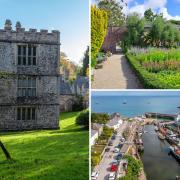From celtic crosses to stone circles - Cornwall’s ancient monuments are filled with legend and folklore, writes Andrew Marshall

As the swirling fog began to close in around me, I clearly remembered the farmer’s words, If you are not back in two hours I’ll sell the car.’ He had been joking, of course, but I still began to wonder. What had started out as an open path, quickly became a deep muddy rut hedged in by needle-sharp gorse that scratched and pulled at my legs as I tried to push through.
What was I doing stumbling around on a Cornish moor, near Land’s End on a drizzly April day, you may well ask - and by the look on my partner’s face, I know she was asking herself the same thing. But the setting was perfect and the atmosphere of inclemency couldn’t be bettered. We climbed up on to a flat area, and there, through a brief parting of the mist we first spotted it. Standing gaunt and stark against a hillside cloaked in purple heather, was the giant chambered barrow of Chun Quoit, a Neolithic burial chamber with its huge capstone seated on four solid walls of rock. It had the power of presence to literally stop us in our tracks.
Megalithic stones are literally scattered across the Cornish countryside and embrace several thousand years of history. From solitary standing stones that point accusing fingers at the sky, holy wells hidden deep within woodlands still used for pagan rites and impressive stone circles that crest the tops of windswept moors - this is a region that retains strong connections with its mystical past.
The wide variety of sacred stone sites make an excellent focus for a car tour of the region and most are marked on good road maps of Cornwall. The Land’s End peninsula in particular has more archeological sites than anywhere else in Britain with around 800 in a 128sq km area. With the abundance of B&B accommodation, boutique seaside hotels, and an ample choice of traditional pubs and tea rooms for refreshments en route, driving Cornwall’s distinctive narrow lanes heading for the next site is a pure pleasure.

Standing alongside Chun Quoit, I was instantly struck by its proportions. It is estimated that the capstone alone weighs more than 8 tonnes. But who built it? How did they engineer the movement and positioning of such colossal rocks? Chambered barrows are believed to be among the oldest sacred stones in Britain, dating between 1500 and 4000BC, once used as burial chambers and most certainly for rituals associated with life, death and the ancestors.
A golden sheath of barley had been freshly placed at the entrance, reminding me that in Cornwall there are still those that believe in the old ways. I had the distinct impression that on that lonely moorland, we were not alone. A flight of fancy maybe, but I still looked over my shoulder, eyes piercing the mist. There was nobody there.
It was while we were zipping along the winding road between Morvah and Penzance in our hire car, that we came across Lanyon Quoit, spied at the last minute through a farm gate. The most photographed of all the Cornish quoits for its immense stature and beauty, Lanyon is however the least authentic, having toppled in a storm in the 19th-century and has since been re-erected. It is none-the-less still impressive, standing on three stone legs like a mammoth sacrificial stone altar dominating the surrounding fields and hills.
There are numerous sacred stone sites near Lanyon Quoit and it’s worthwhile exploring the district on foot. Most sites are accessed by narrow lanes between fields which are a joy to walk along, flanked by Cornwall’s famous high hedgerows, a combination of drystone walling packed with mud and allowed to overgrow with wildflowers and ferns. Ancient treasures such as Celtic crosses and holed stones often lie hidden within them waiting to be discovered.

A little further up the lane way we detoured off, tramping out over Ding Dong Moor. Passing an ancient burial barrow with its kerb stones peeking out from the gorse and bracken, we eventually came to the Nine Maidens. There can be nothing quite so evocative of our pagan origins than a stone circle – and in my mind’s eye I saw barefooted maidens dancing in and out between the stones dressed in diaphanous gowns with flowers in their hair. Pure fantasy.
It was a late sunny evening when we hiked up to Cornwall’s most famous sacred site - the holed stone known as Men-An-Tol. The liquid notes of a skylark on the wing washed over us as we approached. Consisting of a one-metre-high holed stone with two standing stones at either end, it was easy to see that this was a place of ancient and not so ancient ceremonial activity.
It is said that children were passed naked through the 400mm wide hole three times and then drawn on the grass three times against the sun as a cure for rickets. Adults also climbed through the hole nine times to achieve healing, and a brass pin placed on top of the stone, would, by its movement give an answer to any question asked.
In a nearby field a great battle was fought some time around the 5th or 6th century AD. The Royal Raven, son of Ryalvran was killed and a standing stone marks the spot, inscribed in Latin Rialobrani cunvali fili of the Royal Raven, son of the Glorious Prince. Dozens of standing stones like this one dot the Cornish countryside, used as farm gate posts, built into hedgerows or standing proud in a lonely field.

The Men Scryfa (as the standing stone is known) is most likely many thousands of years older than its inscription belies and there is much debate as to the likely use of these stone pinnacles. Tribal boundary posts, burial stones or markers of magical ley lines that dissect the land from one sacred site to the next, one thing is certain, Cornwall is a land that retains many mysteries and is loath to give them up.


























